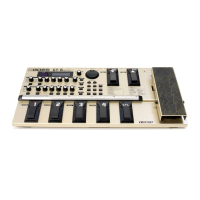
Do you have a question about the Boss GT-6 GT-6 and is the answer not in the manual?
| Type | Multi-effects processor |
|---|---|
| Sampling Frequency | 44.1 kHz |
| Nominal Output Level | -10 dBu |
| Nominal Input Level | -10 dBu |
| Input Impedance | 1 MΩ |
| Dynamic Range | 100 dB |
| Inputs | 1 x Guitar, 1 x Aux |
| MIDI | IN/OUT |
| Expression Pedal | CTL/EXP Pedal |
| Display | LCD |
| Power Supply | AC Adaptor (9 V DC) |
| Effects Types | Distortion, Overdrive, Modulation, Delay, Reverb, Wah |
Using panel knobs to quickly adjust patch tone settings.
How to turn individual effects on and off within a patch.
Editing individual effect parameters for precise sound creation.
Detailed explanation of the Preamp/Speaker Simulator effect.
Explanation of the Overdrive/Distortion effect and its types.
Detailed explanation of the Delay effect and its parameters.
Explanation of the Chorus effect and its parameters.
Explanation of the Reverb effect and its parameters.
Explanation of the Wah effect, including Pedal Wah, Auto Wah, and Fixed Wah.
Explanation of the Equalizer effect and its parametric controls.
Description of the FX-1 block and its available effects.
Description of the FX-2 block and its available effects.
Explanation of the Harmonist effect and its parameters.
Explanation of the Phaser effect and its parameters.
Explanation of the Flanger effect and its parameters.
Explanation of the Pitch Shifter effect and its parameters.
Explanation of the Pedal Bend effect and its parameters.
Explanation of the Vibrato effect and its parameters.
Explanation of the Humanizer effect and its modes.
Explanation of the Ring Modulator effect.
Explanation of the Slicer effect.
Explanation of the Auto Riff effect.
Explanation of the Guitar Synthesizer effect.
Explanation of the Sub Equalizer effect.
Explanation of the Noise Suppressor effect.
Explanation of Master settings like Patch Level and Master BPM.
Controlling effects using various external devices and MIDI.
Creating custom preamp tones.
Creating custom overdrive and distortion tones.
Creating custom wah pedal tones.
Controlling the GT-6 from external MIDI devices.
Configuring MIDI settings like channels and clock sync.
Overview of transmitting and receiving MIDI data.
Sending system settings and patch data via Bulk Dump.
Receiving system settings and patch data via Bulk Load.
Mapping MIDI Program Change messages to GT-6 patches.
Activating or deactivating Program Change Map settings.
Guide to resetting the GT-6 to factory default settings.
Solutions for issues with sound or low volume.
Solutions for MIDI communication problems.
Explains common error messages and their solutions.
